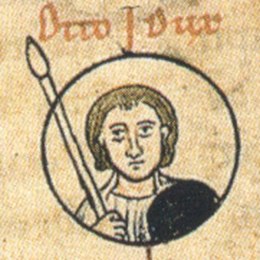Otto I. (Saxony)
Otto I , the Illustrious (* 830/40, † November 30 912 ) from the noble family of Liudolfinger was 902-912 lay abbot of Hersfeld .
The younger son of Count Liudolf became the head of the Liudolfinger family in 880 as the successor to his brother Brun, who died in the Norman Battle. Otto was count in Derlin (g) gau, in southern Thuringia and in Eichsfeld .
In a tithe directory of the Hersfeld monastery, he is attested as "Duke" (dux) as early as the end of the 9th century. Even King Konrad I , a long-time rival, referred to him in retrospect in 913 as dux . Fifty years later Otto von Widukind von Corvey was even referred to as the Duke of all of Saxony. On the other hand, the Carolingians refused him the dux title and only honored him in their documents as an outstanding count.
Otto probably married Hadwig around 875, a daughter of a nobleman named Heinrich , who belonged to the Franconian noble family of the older Babenbergs. Otto had the following children with Hadwig: Thankmar, Liudolf, the later King Heinrich I and Oda .
Otto accompanied Arnolf on the Italian train in early 894. At the request of the Pope, Arnolf was supposed to fight the tyrant Emperor Wido von Spoleto . Otto was given the task of securing the city of Milan. A few years later he received the Hersian Reichsstift Hersfeld for his loyal service . As a lay abbot , he had significant influence on this important institution in the Saxon-Franconian border area. Otto's importance in the power structure of the East Franconian Empire is shown in the fact that his daughter Oda was married to Zwentibold , the son of Emperor Arnolf. Through this marriage, the emperor tried to integrate Otto as the most powerful man in eastern Saxony into the Carolingian ruling family.
Under the new ruler Ludwig the child , Otto was not particularly close to the royal court. He had to limit himself to his core areas in the north-east of the empire on the Harz and the Elbe. Otto appeared only twice as an intervener, in August 902 in Trebur in a legal confirmation for the church of Halberstadt and on 8 May 906 in Holzkirchen in a legal confirmation for the church in Freising. According to the Saxon historian Widukind von Corvey , after the death of Ludwig the child, the "people of the Saxons and Franks" offered Otto the royal crown. But he refused for reasons of age. True power is said to have remained with Otto.
Otto the illustrious was buried in the church of the Gandersheim monastery . A plaque about him is in the Walhalla in Donaustauf .
literature
- Wolfgang Giese : Liudolfinger. In: New German Biography (NDB). Volume 14, Duncker & Humblot, Berlin 1985, ISBN 3-428-00195-8 , p. 718 f. ( Digitized version ).
- Ernst Steindorff : Otto, Duke of Saxony . In: Allgemeine Deutsche Biographie (ADB). Volume 24, Duncker & Humblot, Leipzig 1887, pp. 723-725.
- Gerd Althoff : Otto d. Illustrious . In: Lexicon of the Middle Ages (LexMA). Volume 6, Artemis & Winkler, Munich / Zurich 1993, ISBN 3-7608-8906-9 , Sp. 1579.
Web links
Remarks
- ^ Wolfgang Giese: Heinrich I. founder of the Ottonian rule. Darmstadt 2008, p. 44.
- ↑ Widukind I, 21.
- ↑ Matthias Becher: Otto the Great. Emperor and Empire. A biography. Munich 2012, p. 62.
- ↑ Hagen Keller , Gerd Althoff : The time of the late Carolingians and the Ottonians. Crises and consolidations 888-1024 (= Gebhardt. Handbuch der deutschen Geschichte Vol. 3). 10th completely revised edition. Stuttgart 2008, p. 63.
- ^ Ingrid Heidrich: The noble family of the Konradines before and during the reign of Konrad I. In: Hans-Werner Goetz (Hrsg.): Konrad I .: On the way to the "German Empire"? Bochum 2006, pp. 59–75, here: p. 72.
- ↑ Widukind I, 16. Cf. Hagen Keller, Gerd Althoff: The time of the late Carolingians and the Ottonians. Crises and consolidations 888-1024 (= Gebhardt. Handbuch der deutschen Geschichte Vol. 3). 10th completely revised edition. Stuttgart 2008, p. 79.
| predecessor | Office | successor |
|---|---|---|
| Harderat |
Abbot of Hersfeld ( lay abbot ) 902–912 |
Diethart I. |
| personal data | |
|---|---|
| SURNAME | Otto I. |
| ALTERNATIVE NAMES | Otto the Illustrious |
| BRIEF DESCRIPTION | Duke of Saxony |
| DATE OF BIRTH | before 850 |
| DATE OF DEATH | November 30, 912 |
